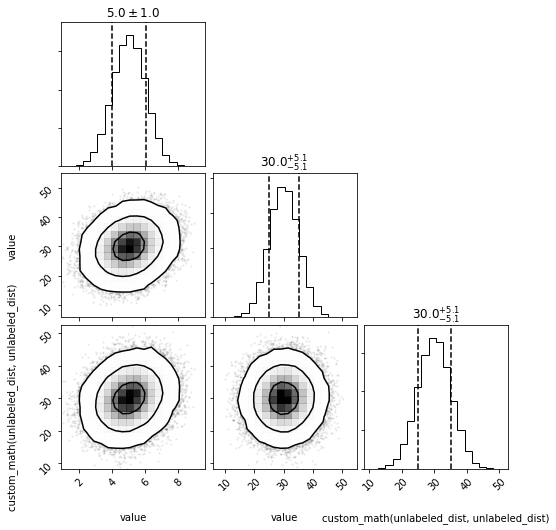import distl
import numpy as np
Copy vs Deepcopy
distl assigns each distribution a uniqueid which tracks whether copies of underlying distributions should be treated as from the same underlying distribution or independent.
Let's first create a gaussian distribution and access its automatically assigned random uniqueid.
d = distl.gaussian(5, 1)
print(d.uniqueid)
qXmRdLGhfHpHnaDtVqhD
When calling copy, this uniqueid is retained which links the new copy to the original.
print(d.copy().uniqueid)
qXmRdLGhfHpHnaDtVqhD
Calling deepcopy, however, assigns a new random uniqueid, effectively unlinking the two distribution objects.
print(d.deepcopy().uniqueid)
tRqFpWAZWlZvWbzHHrYQ
Implications in CompositeDistributions and math operations
By default, using math operators on distributions will use copy. To force unlinking the distributions, you must call deepcopy manually.
Here we'll show that the original distribution and the distribution after applying math operators maintain the same uniqueid, by default, and are therefore sampled simultaneously.
d = distl.gaussian(5, 1)
print(d.uniqueid)
yzjcXLHzImrgJDsJGKms
print((5*d).uniqueid)
yzjcXLHzImrgJDsJGKms
We can see the implications of this in action when a CompositeDistribution contains two or more "copies" of the same underlying distribution.
In this case, we'll create a distribution for d + 5*d. By default, the underlying references to d will remain linked when creating the CompositeDistribution (i.e. when sampling the CompositeDistribution, the same value will be drawn from all instances of d before applying the math operators between them).
comp = d + 5*d
_ = comp.plot(show=True)

If we instead force the two instances to be unlinked by using a deepcopy, the two references to d are sampled independently before applying the math operators. Here we can see that this does result in a slightly different distribution (in the case of simple operations between gaussian distributions, this only affects the spread on the resulting distribution).
comp_indep = d + 5*d.deepcopy()
_ = comp_indep.plot(show=True)
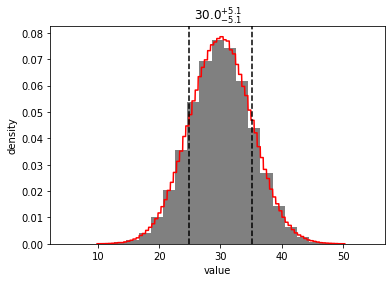
Implications in Function Distributions
Similarly, a Function Distribution will sample from any input distributions following these same rules. This does work even if vectorized=False, although it does get more computationally expensive.
def custom_math(a, b):
return a + 5*b
f = distl.function(custom_math, args=(d, d))
_ = f.plot(show=True)
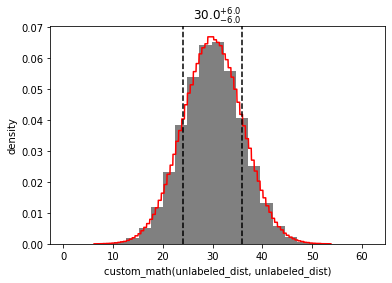
f_indep = distl.function(custom_math, args=(d, d.deepcopy()))
_ = f_indep.plot(show=True)
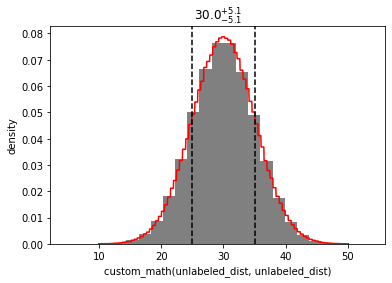
Implications in DistributionCollections
This sampling logic can be seen even more clearly in the corner plots within DistributionCollections. First we'll create a collection with d and 5*d. Since this creates a linked copy by default, we can see that the resulting samples strictly follow a 1:1 relationship.
dc = distl.DistributionCollection(d, comp, f)
_ = dc.plot(show=True)
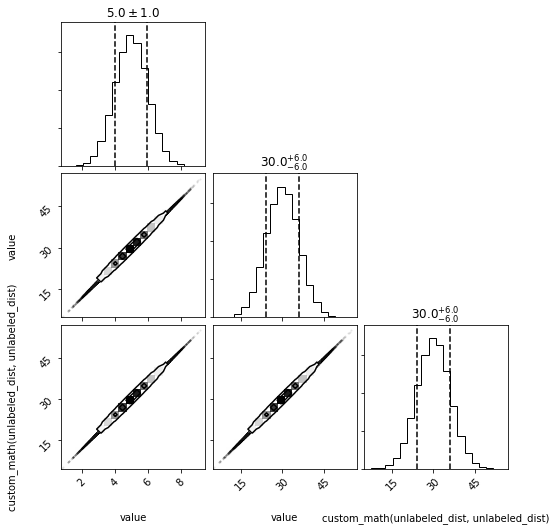
If instead we force a deepcopy, both resulting Gaussian distributions are sampled independently from each other and no longer show this correlation.
dc_indep = distl.DistributionCollection(d, comp_indep, f_indep)
_ = dc_indep.plot(show=True)
